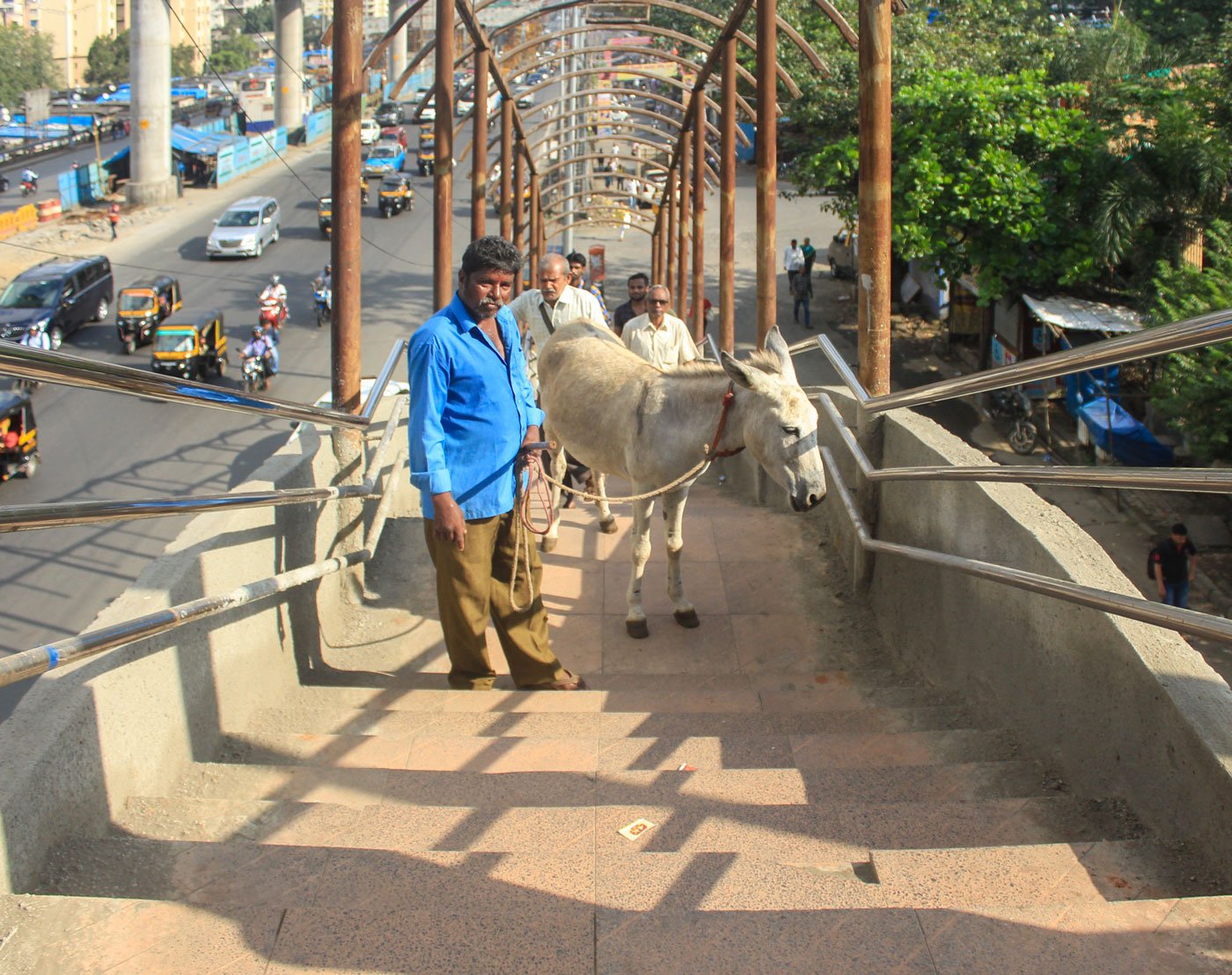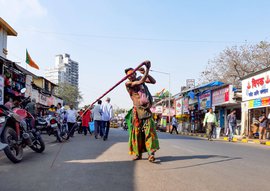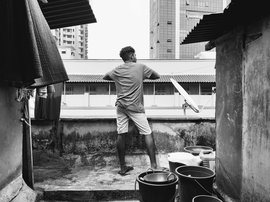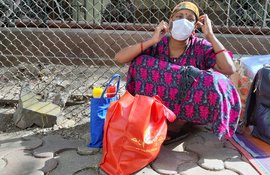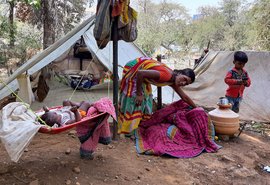“ Gadhe ka doodh, bachcha majboot [Donkey’s milk, robust child],” said a voice. I turned around, astonished.
There stood Sukhdev, with Kajol nodding and silent. She uttered not a sound, walking stoically beside him.
I was amazed, but the people on that street in Malad barely glanced at Sukhdev leading Kajol with a rope around her neck and a stick he occasionally hit on the ground to keep her in line.
At times, instead of eight-year-old Kajol, it’s Rani, also eight, who walks door to door while Sukhdev extols the virtues of donkey milk. Rani was at home that day, in the Appapada slum in Malad East. Standing with her in the pada was Kajol’s five-month-old foal. Two-year-old Langdi, who was born with a deformed right hind leg, was back home too.
With them usually are six more female donkeys owned by Sukhdev’s extended family – his nephew Ramdas owns Muda, while his elder brother Waman owns five, who have no fixed names.
Sukhdev is “ pagal about films” says his wife Jayshri, so their donkeys are usually named after Bollywood film stars – there was a Madhuri Dixit too in the past.
Humans and donkeys all live together on a hilltop in Appapada in suburban north Mumbai. The people in closely packed huts, the donkeys tied nearby with ropes entwined around poles. The neighbours don’t seem to mind. “They have been here much before we came here,” says Sahil, who lives in the same pada .
The foal’s father is Raja, who had become notorious, they say, for running around and butting people. “He used to do a lot of masti [mischief], make the jennies [female donkeys] run behind him, push people walking on the streets – though he never harmed anyone,” says Ramdas, who owned Raja. So he sold him off four months ago in their village.
The Jadhav family members sometimes buy and sell donkeys at the annual Khandoba temple fair in Jejuri taluka of Maharashtra’s Pune district, where people from various states come to trade in the animal. Prices range from Rs. 5,000 for infirm animals, to Rs. 25,000 for tenacious donkeys who can carry heavy loads.
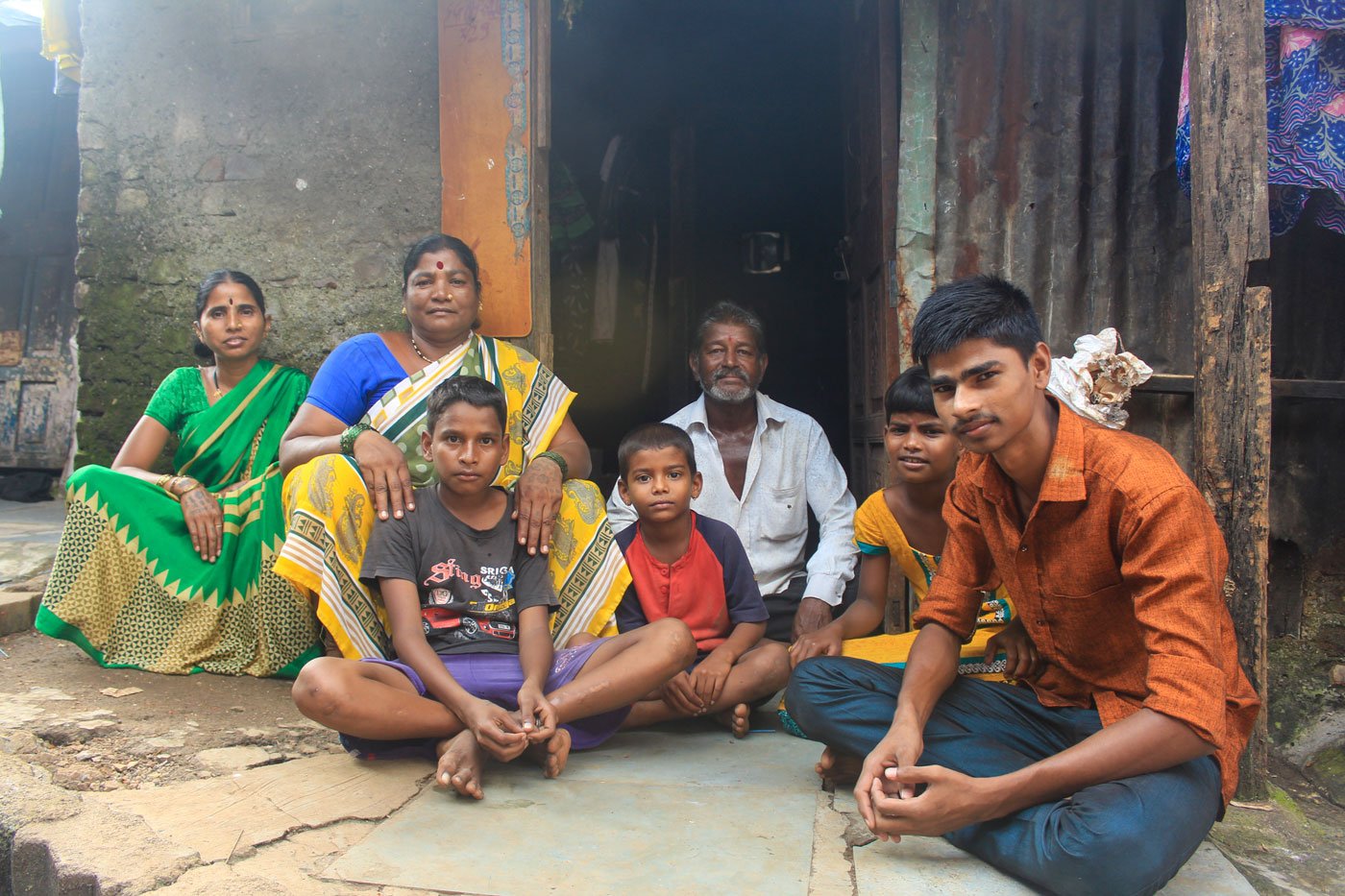
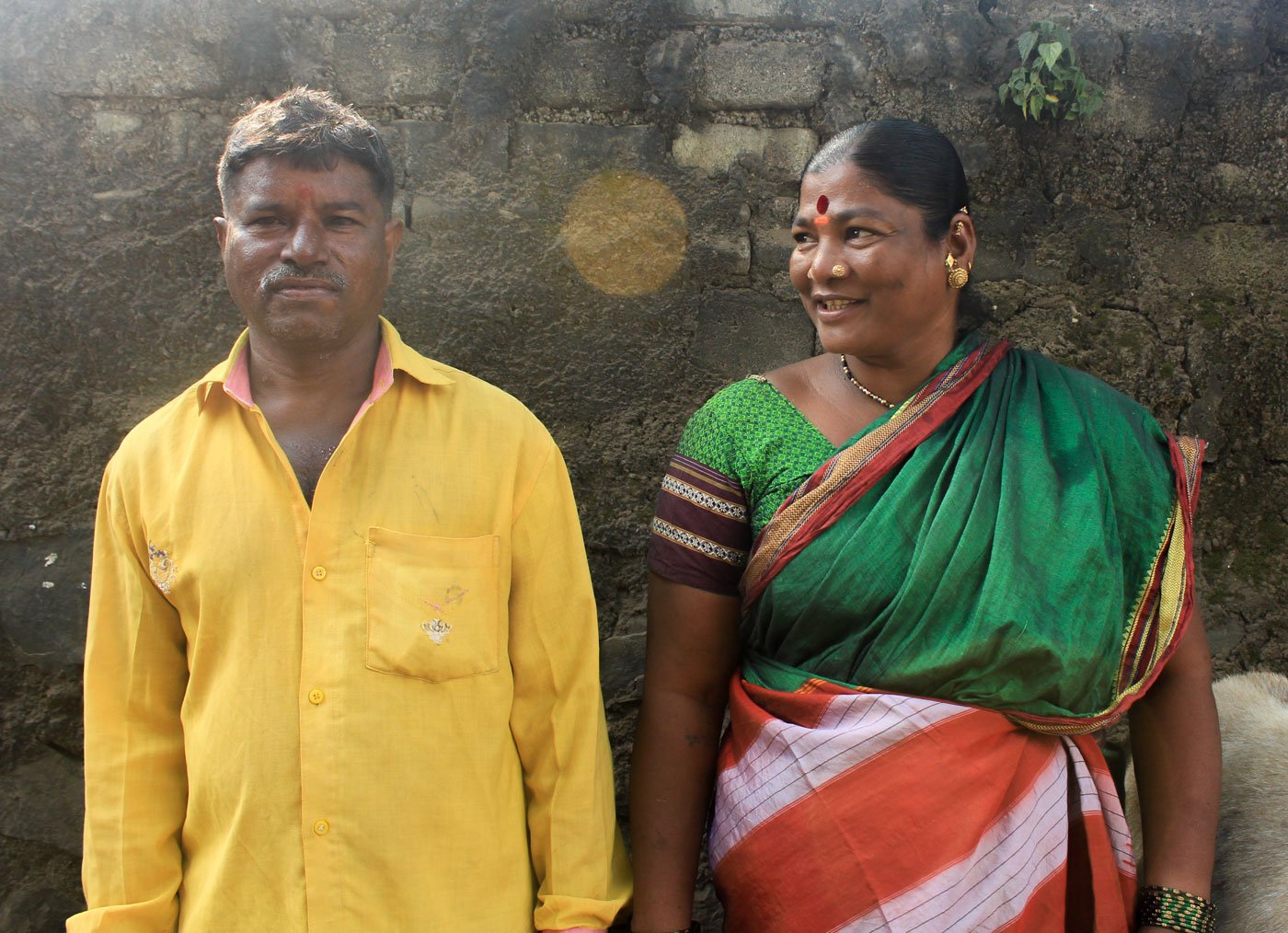
Some of the family members (left to right) – Sangeeta (Ramdas's wife), Jayshri, grandkids, and Waman (in the doorway). Right: Sukhdev is ' pagal about films' says Jayshri
I ask Sukhdev about his village. With great pride, he tells me, “Have you seen Sairat [a Marathi film released in 2016]? That picture was shot in our village. We are from that village.” The whole family describes their village thus, where the hit film was shot – in Karmala in Solapur district.
They are from the Vaddar community (listed as an OBC in Maharashtra). Sukhdev’s father and grandfather owned donkeys. “In the village [and in nearby villages], we would help construct ponds, houses, small dams – our donkeys carried the loads,” says 52-year-old Sukhdev. “Whatever we earned, we ate and lived on,” adds Jayshri, who is 38.
Work was available, but the times were tough. "There were periods of drought,” Sukhdev says. “If we had roti then there was no sabzi to eat with it. We were thirsty but had no water to drink.” Besides, the family was growing, they didn't own any land, and, over time, the work was becoming harder to find. They had heard from relatives of the forest in Mumbai where their donkeys could roam and feed. And they had heard that the work and wages in the city were more plentiful.
In 1984, a large contingent of the extended Jadhav family – Sukhdev’s parents, his six brothers, various children – and other community members came to Mumbai. With them were “100s of donkeys.”
They all came walking, Sukhdev says, only a few of them at times using tempos since it was not possible to bring all the donkeys in vehicles. It took 11-12 days to walk the roughly 325 kilometres from Karmala to Mumbai, he recalls. “Wherever we saw dhabas we used to eat.”
Looking for a wide open space in Mumbai, they arrived in Appapada in Malad. The area, then an extension of the national park at Borivali, was densely forested. “Our donkeys could roam anywhere [in the forest], eat anything,” says Sukhdev. “Now you see people [in this locality] because we settled here first.”
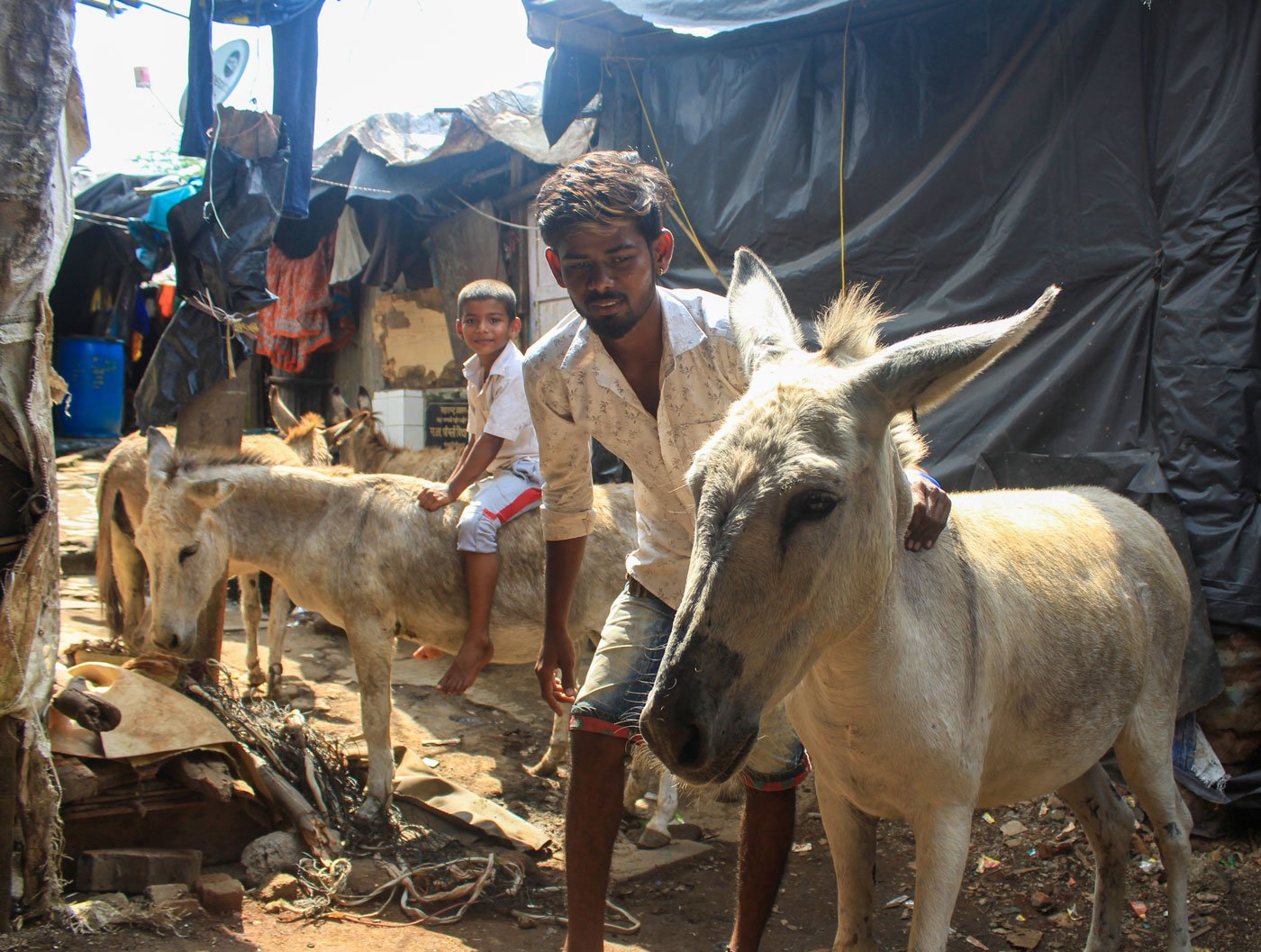
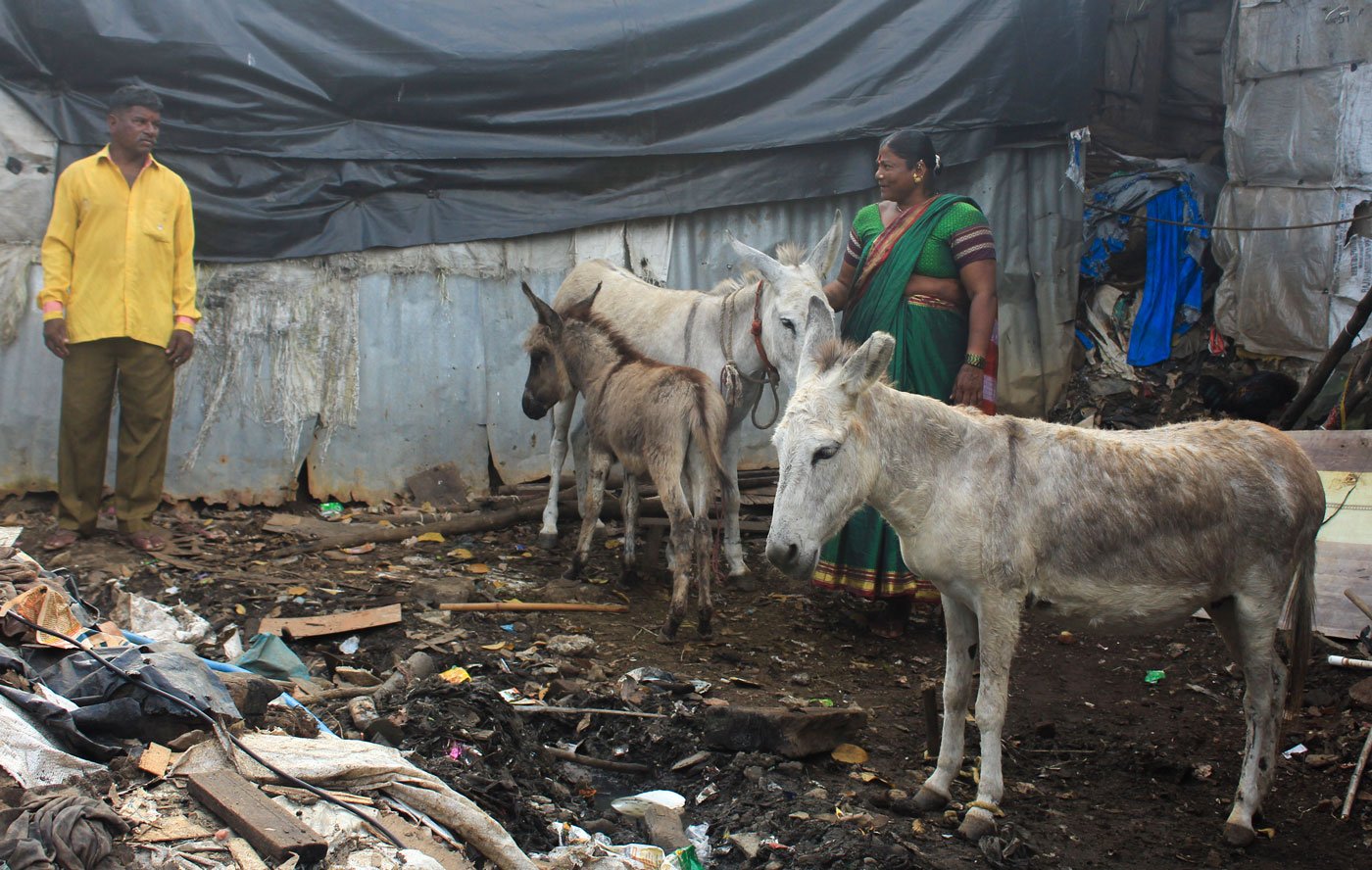
Left: Anand Jadhav and his little cousin Yuvraj Shinde, both used to the donkeys in their midst. Right: Sukhdev and Jayshri with their menagerie
The building spurt in Mumbai had not quite begun in the mid-1980s, but there was enough work for the Jadhav family’s donkeys at construction sites and with the railways, carrying bricks and sand and other loads. “Who made Thakur village, Hanuman Nagar, Mahavir Nagar?” Sukhdev asks, referring to suburban colonies. “We did, with our donkeys.”
“Our people worked together with 10-15 donkeys,” Jayshri recalls. “We got money collectively for a day, which we divided among ourselves – sometimes 50 rupees, sometimes 100.”
But by around 2009-2010, they recall, animal rights groups started objecting to the heavy loads the donkeys had to carry. “These sanstha [NGO] people said there should be no violence against animals,” Ramdas, who is in his mid-40s, says angrily. So the builders now don’t hire donkeys, he adds. “I have been doing this work since my father’s and grandfather's time. They are kicking not only my belly but even theirs [the donkeys’]. Even human beings carry loads, no one has a problem with that?”
Besides, over time, with the growing use of heavy machinery, the donkey’s role at construction sites has diminished, says Jayshri. “The machines now lift the loads, like our donkeys did in the past.” Ramdas still finds work sometimes at hillside construction sites. “Where the truck cannot go, the donkey is used to carry the loads,” he says. But this is rare.
Left with no work, a few of the Jadhav family members returned to Karmala or went to Pune in search of a livelihood. Most of the family members who have stayed back in Mumbai find daily wage labour, earning Rs. 300-400 a day. “What other work to do? We go there, go here for begari work. One day I get work, next two days I don’t,” says Ramdas. He retains Muda, his one female donkey, “for my happiness” he says, having grown up around the animals.
At times, Sukhdev’s 21-year-old nephew Anand, his elder brother Waman’s son, takes a robust jenny named Power to Film City in Goregaon. There the animal features fleetingly in a film or television serial, and they return with Rs. 2,000 for a 3-4 hour shoot. But this work comes along rarely – and requires a Power-like animal.
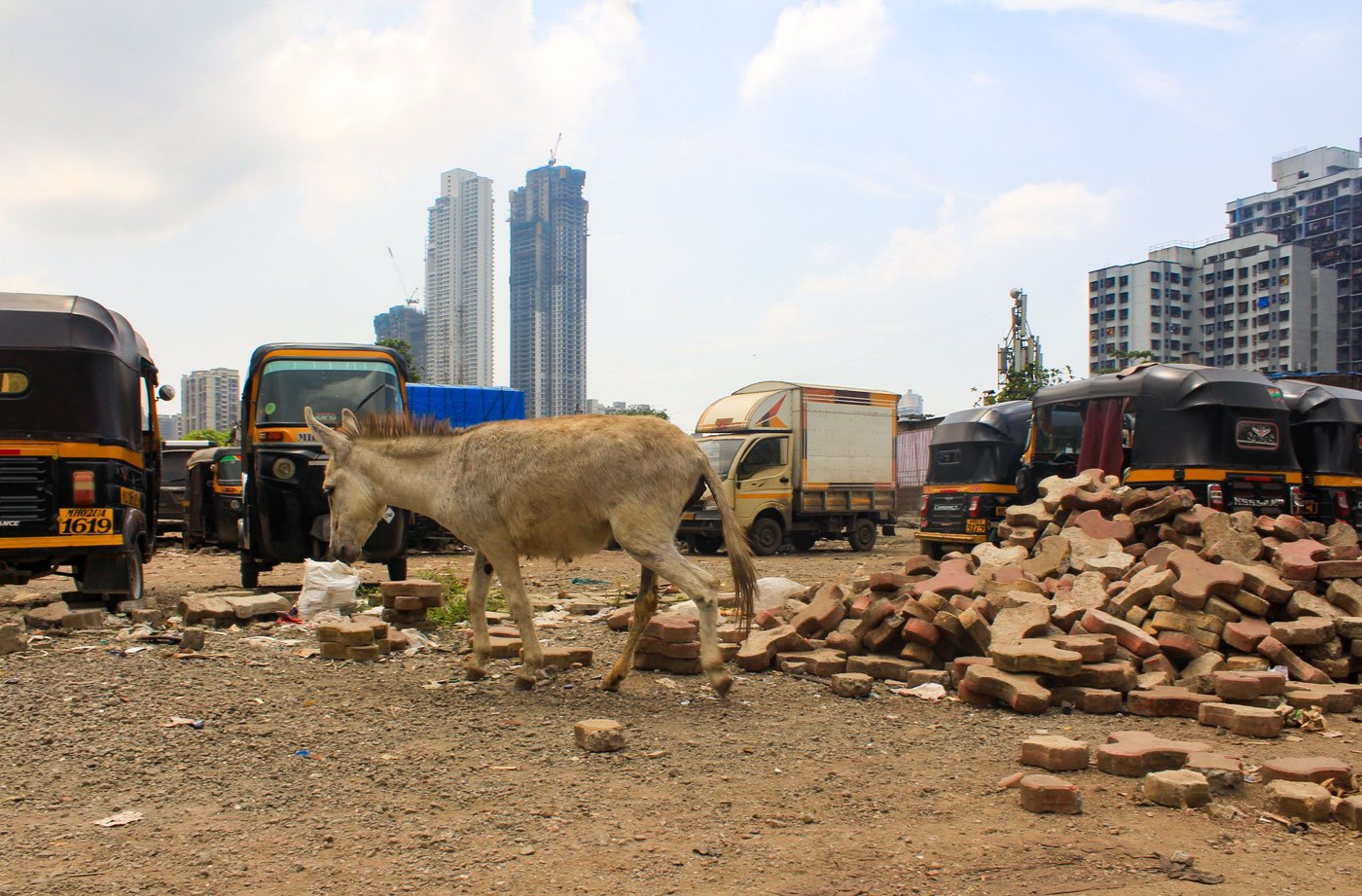
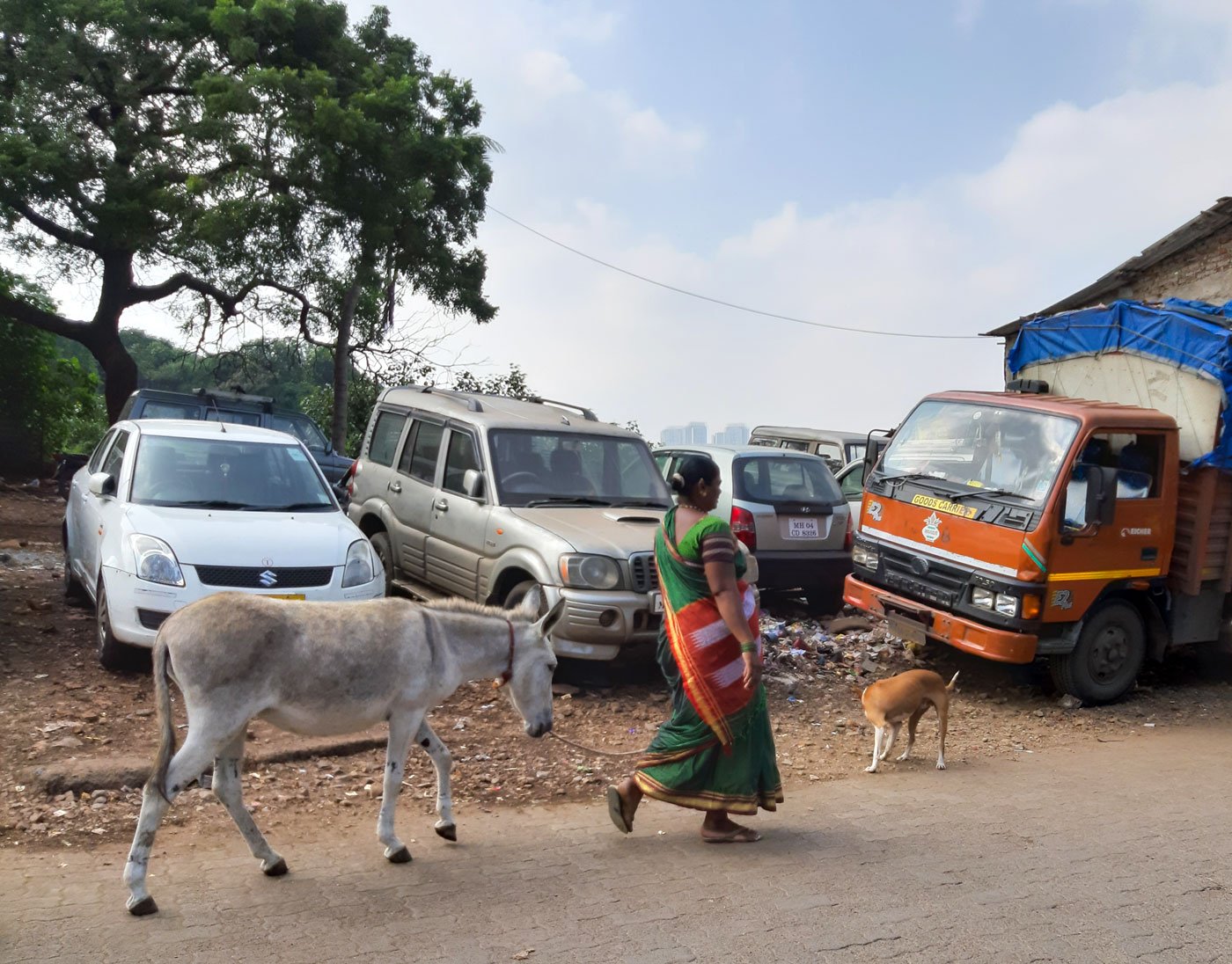
Jayshri and Sukhdev start out around 7 a.m. with Kajol or Rani, and go to various slum colonies and chawls looking for customers
So Sukhdev and Jayshri, left with few options after the construction site work dried up, started selling milk door to door. Sukhdev’s family had occasionally sold donkey’s milk even in their village. Usually someone with an ailing family member would come asking for the milk, which is believed to be highly nutritious.
They start out around 7 a.m. (and return by 4 p.m.), and go to various slum colonies and chawls , along changing routes, looking for customers. At times, they even walk as far as Virar, nearly 50 kilometres away. “Wherever my Lakshmi [referring to the donkey as the goddess of wealth] takes me, I go,” Sukhdev says.
The donkey is milked on the spot. The milk has to be consumed immediately and in small quantities. Sukhdev and Jayshri carry a spoon for this purpose. “This is medicine, all your cough, fever, body heat will go away, and it helps the growth of children. Doctors have just arrived, earlier this milk used to be given,” says Jayshri. The liquid, she is sure, contains as much nutrition as a human mother’s milk. “Drink it and see how strong it will make you.”
In the past, in their village, the Jadhav family sold the milk for Rs. 2 a spoon. Now the rate is usually Rs. 50 for 10 ml. “ Jaisa desh waisa bhais ,” Sukhdev says, referring to how he adapts the price according to the customer. "At this plastic-covered dwelling [pointing to a hut] the rate is 30, for pucca houses it is 50-60 rupees, and for big building people it is Rs. 100.” Some, he says, even ask for a cup or small steel glass full of milk, which costs Rs. 500. But that request is rare.
Do they get enough customers? Suraj, their 20-year-old son, responds: “No, very few people know about donkey’s milk. Only village people or old people know its value. A young boy or girl today won’t know about it at all.”
At times people note down Sukhdev’s phone number and address so that they can get the milk when required. “People come here [to their Appapada home] from Andheri, Khar, Nalasopara…” Jayshri says.
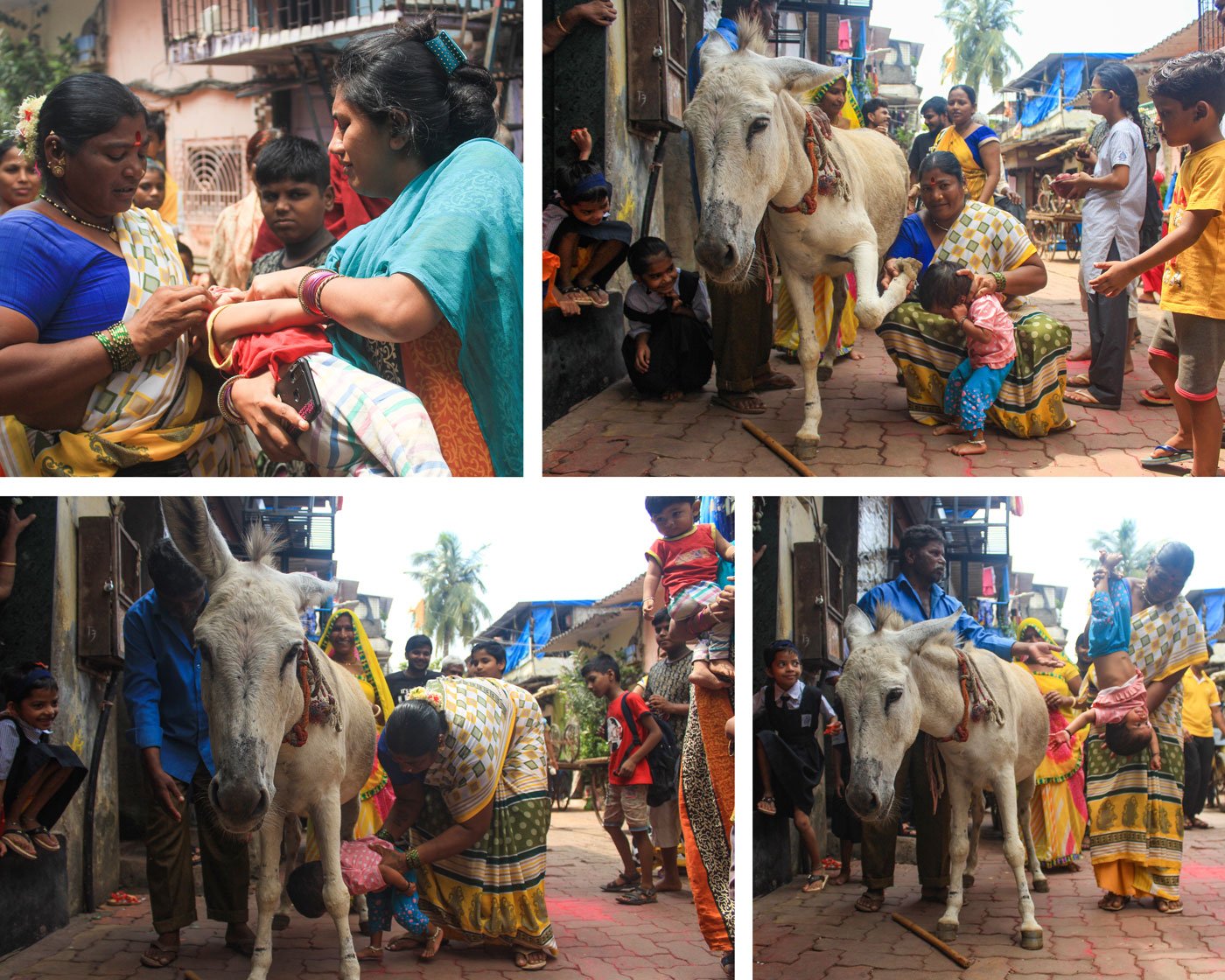
The customers are usually those with a newborn baby at home or with an unwell family member. Sometimes parents also request this ritual (photos above) to be performed
The customers who seek the donkey milk are usually those with a newborn baby at home or with an unwell family member. “If you drink it for three days, all your weakness will go. You get better in 5-6 days,” says Jayshri. The family gets more customers during winters, seeking relief from chills and fevers.
Sometimes parents also request a ritual to be performed – the nazar nikalna . After the child is fed the milk with a spoon, Sukhdev or Jayshri touch his or her head to the donkey’s back, leg and tail. Then, if the toddler is not crying too much, they pass him or her under and above the donkey. And then, for a quick moment, they hold the child in the air and turn it upside down. This, they and the parents believe, wards off any evil eye.
Sukhdev and Jayshri's earnings total between Rs. 500 and Rs 1,500 a day – but they set out only 3-4 times a week, on the other days resting donkeys and selves.
Their work entirely depends on having a female who has recently delivered a foal. The foal, Jayshri tells me, has its mother's milk for nine months, after which the jenny stops lactating. When that happens to Kajol, she will be sold along with the foal, and Jayshri and Sukhdev will buy another donkey with a newborn. To procure a pair from dealers they know in Thane district, they have to wait sometimes and alert the agents in advance.
The donkeys have to be fed well. “They eat everything,” Jayshri says. “They also roam and eat in the jungle [the nearby forested areas of the national park]. They eat cucumber, dal , rice, whatever is there, they eat.” Their favourite snack is jowar and wheat grains. They also get leftovers chapatis from some of their regular customers. The family spends Rs. 700 to Rs. 1,200 a month, Jayshri says, to feed their three female donkeys.
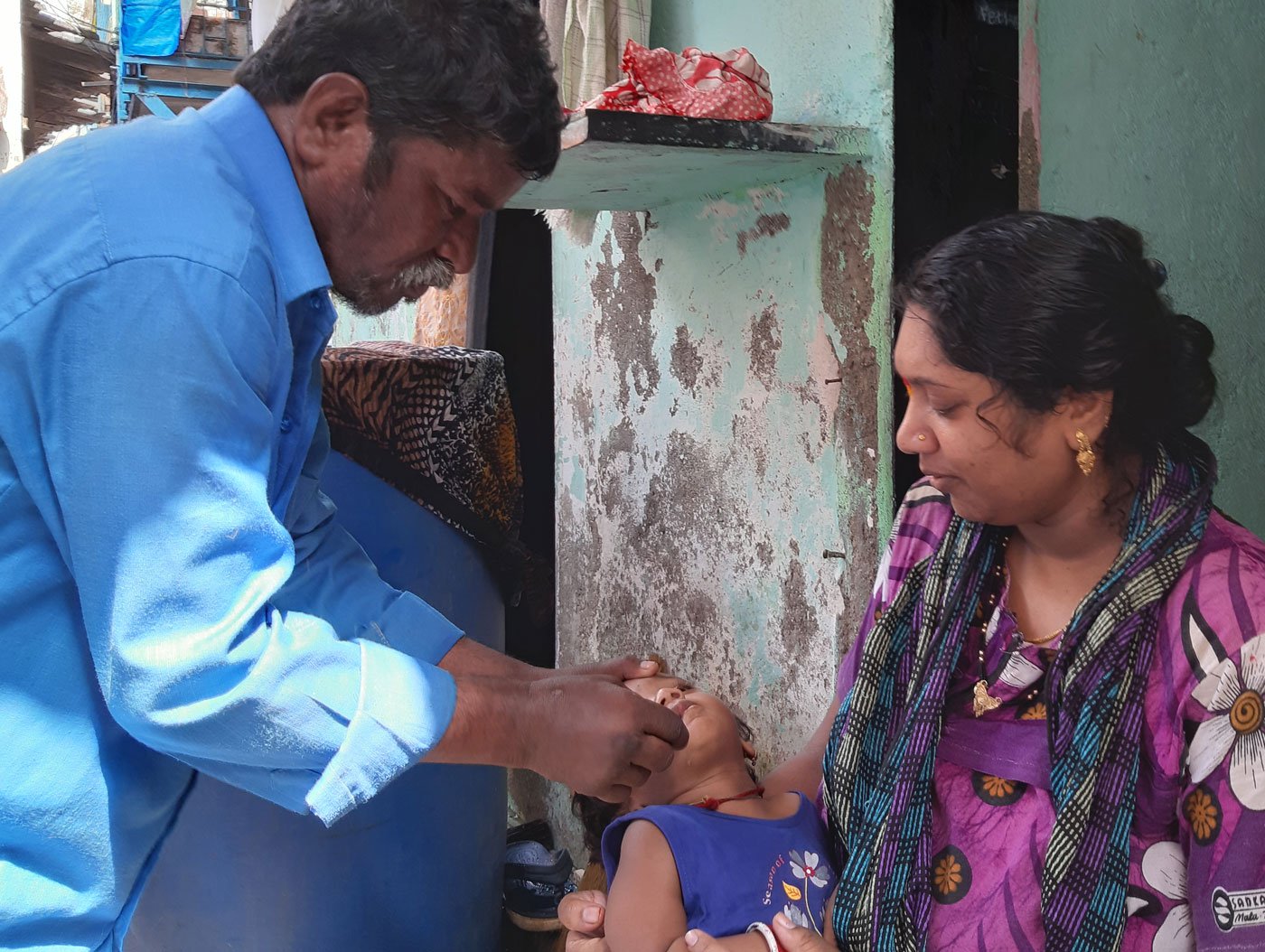
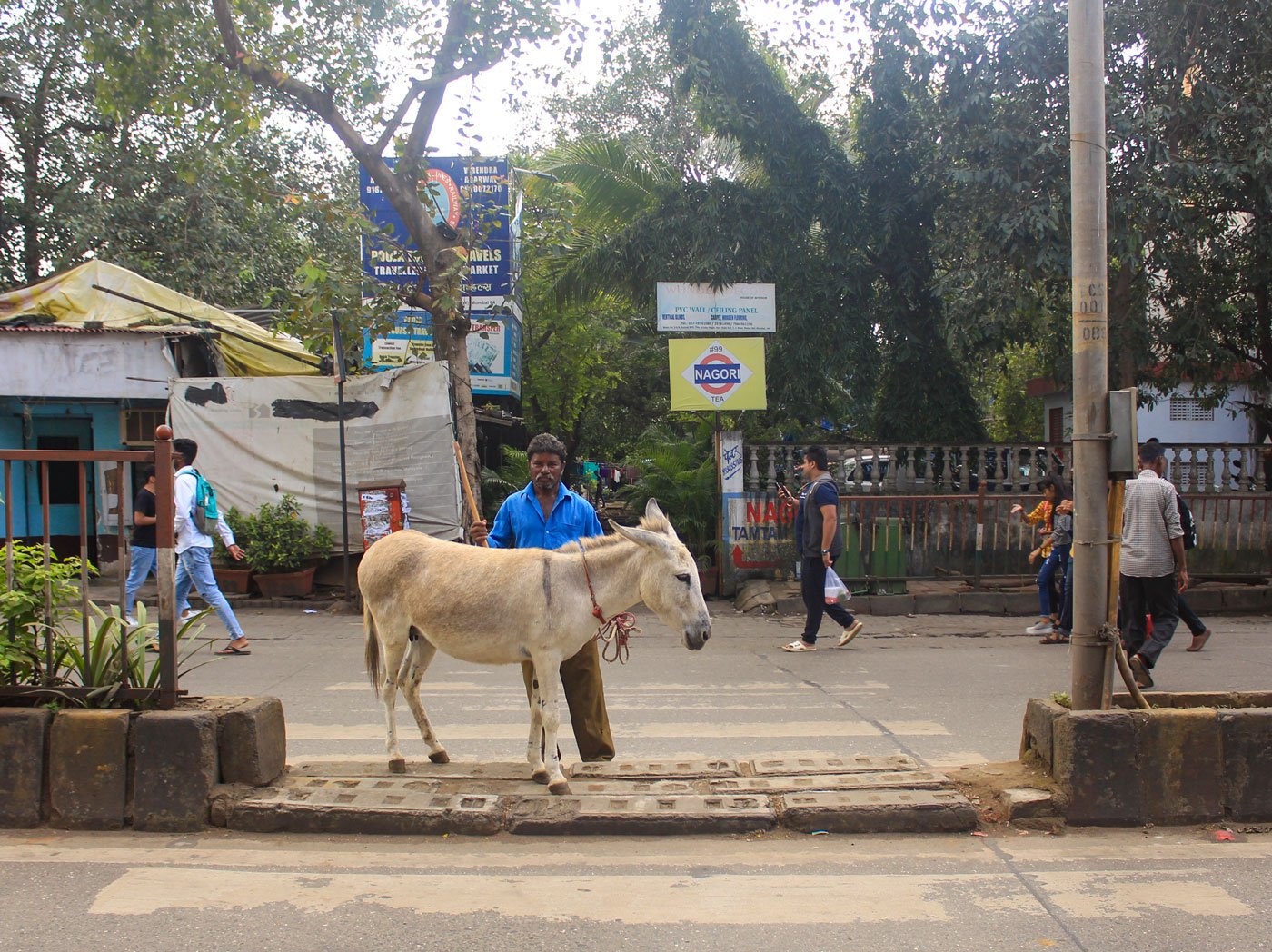
'Drink it and see how strong it will make you'
Taking care of the animals in congested Mumbai is not easy. They need open spaces. When the Jadhavs leave them to roam around, they usually return by evening. But there have been times when they have not returned for days. “We then roam around looking for the donkey, asking people, and bring it back,” says Sukhdev.
“When the donkey returns, we know by its face if he or she wants to tell us something,” adds Suraj. “It will push or hit with its tail. If it has hurt a leg, it will shake it and show.”
And there are times when the animals don’t return. Some of the donkeys walked away years ago, never to be found. When this increased, in a constantly growing and crowded city, the extended family sold their animals or sent them back to Karmala.
Suraj loves the donkeys. He and his brother, Akash, 22, both dropped out of high school and do daily wage labour wherever they find work. Remembering Gutaki, his favourite, Suraj says, “She was my best friend since I was a child till I became 15. I never used to sit on any other donkey. I would go with her to the jungle for hours and shared all my secrets with her.” When Gutaki died in a road accident on the highway in Malad, Suraj cried for hours.
When the donkeys die – life-spans range from 15-20 years in India – the Jadhavs say they are buried among the trees of the national park.
The Jadhav family is eligible to be re-accommodated in a Slum Redevelopment Authority flat in their area. They have the required proof of residence. When that happens, Suraj hopes that they get a little space to keep the donkeys. “Or some might stay, the others will leave for the village,” he says. At this, Sukhdev exclaims, "Oh my god, no. Without them, I will go nowhere.”
